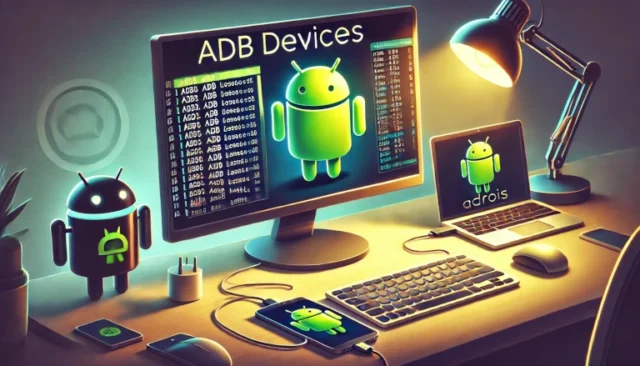The adb devices command is one of the most fundamental and powerful tools available for Android developers, testers, and even tech enthusiasts. It provides a seamless way to list and connect Android devices via Android Debug Bridge (ADB), allowing you to interact directly with your phone or tablet from your computer. Whether you’re developing an app, testing features, or simply exploring the capabilities of your Android device, learning how to use adb devices effectively is an invaluable skill.
In this post, we will explore what adb devices is, how it works, how to set it up, and common issues with solutions that you may encounter when using the command.
What is ADB Devices Command?
ADB (Android Debug Bridge) is a command-line utility included in the Android SDK that allows users to interact with Android devices from a computer. The adb devices command is used specifically to check which devices are connected to your computer via USB or over a network.
- Why Use adb devices?
- List Connected Devices: Easily list all Android devices connected via USB or network.
- Verify Connection: Check if ADB can detect your device properly, which is crucial for debugging or testing purposes.
- Enable Debugging: Start debugging sessions by confirming that devices are connected and properly recognized by the ADB.
Example: Imagine you’re a developer with multiple Android devices connected to your computer. With the adb devices command, you can quickly see which devices are available and ready for debugging.
How to Set Up ADB on Your System
Before you can use the adb devices command, you’ll need to set up ADB on your computer. Here are step-by-step instructions for various operating systems.
Step 1: Install ADB
- Windows:
- Download the Android SDK Platform Tools from the official Android developer website.
- Extract the downloaded files to a folder on your computer.
- Add the directory to your system’s PATH environment variable for easy access.
- Linux:
Run the following command to install ADB tools:
sudo apt-get install android-tools-adb- MacOS:
Use Homebrew to install ADB:
brew install android-platform-toolsStep 2: Enable USB Debugging on Android Device
- On your Android device, go to Settings > About Phone.
- Tap on Build Number multiple times until Developer Options is enabled.
- Go to Developer Options and enable USB Debugging.
How to Use adb devices Command
Once you have ADB set up and your device connected via USB or Wi-Fi, you can use the adb devices command to verify the connection.
Basic Usage
Open a terminal window and type the following command:
adb devices- Output:
- If the device is properly connected, you’ll see a list of connected devices along with their serial numbers.
- If there are no devices connected or if ADB cannot detect the device, you may see “unauthorized” or “offline” status.
Example Output:
List of devices attached
emulator-5554 device
1234567890ABCDEF offline- emulator-5554: Represents an Android emulator connected.
- 1234567890ABCDEF: Represents a physical Android device.
How adb devices Command Works
The adb devices command communicates with the adb server, which is responsible for managing all connected devices. It allows you to see which devices are connected, authorized, and ready for interaction.
- Connected Devices: ADB can connect to Android devices via USB or Wi-Fi.
- Status Codes:
- Device: The device is connected and ready for communication.
- Offline: The device is connected but cannot communicate with ADB, often due to USB connection issues.
- Unauthorized: The device needs to authorize your computer to enable debugging.
Troubleshooting Common Issues
1. Device Not Detected
Problem: The device does not appear when running the adb devices command.
Solution:
- USB Cable Check: Ensure you’re using a data cable that supports file transfers (some cables are for charging only).
- Enable USB Debugging: Make sure USB Debugging is enabled on your device.
- Restart ADB Server: Restart the ADB server using:
adb kill-server
adb start-server2. Device Unauthorized
Problem: The device shows as unauthorized.
Solution: Look for a prompt on your device asking you to authorize the computer for USB debugging. Tap Allow to authorize.
3. Device Status Offline
Problem: The device appears as offline in the adb devices list.
Solution:
- Re-plug the USB cable to establish a new connection.
- Reboot Device: Restarting the device can help resolve connectivity issues.
Using adb devices with Wi-Fi
ADB can also connect to Android devices over Wi-Fi, which is useful if you do not have a USB cable handy or need to connect multiple devices.
Steps to Connect Over Wi-Fi:
- Connect your Android device to your computer via USB and run:
adb tcpip 5555- Find the device’s IP address using:
adb shell ifconfig wlan0- Connect to the device using its IP address:
adb connect <IP_ADDRESS>:5555Best Practices for Using adb devices
- Use Reliable Cables: A good quality USB cable is crucial for maintaining a stable connection.
- Authorize Devices: Always make sure your Android device is authorized to communicate with your computer.
- Check Developer Options: Enable the necessary developer options, such as USB Debugging.
Conclusion
The adb devices command is an indispensable tool for anyone working with Android development or testing. It allows you to see and verify connected devices, resolve connection issues, and even connect via Wi-Fi. Whether you’re a beginner or an experienced developer, mastering this command will significantly improve your efficiency when working with Android devices.
By following this guide, you will be able to troubleshoot common issues, understand how ADB communicates with your Android device, and effectively use adb devices for seamless development and testing experiences.

1 thought on “ADB Devices Command: Connect, Debug, and Control Android Effortlessly!”